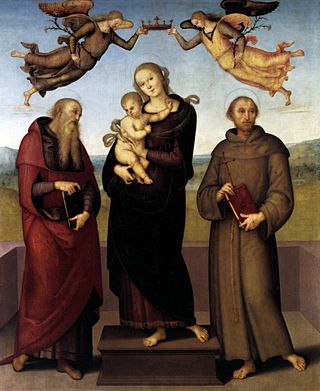
Filippino Lippi was an Italian painter working in Florence, Italy during the later years of the Early Renaissance and first few years of the High Renaissance.

Domenico Veneziano was an Italian painter of the early Renaissance, active mostly in Perugia and Tuscany.

Pinturicchio, or Pintoricchio, also known as Benetto di Biagio or Sordicchio, was an Italian painter during the Renaissance. He acquired his nickname because of his small stature and he used it to sign some of his artworks that were created during the fifteenth and sixteenth centuries.

Pietro Perugino, an Italian Renaissance painter of the Umbrian school, developed some of the qualities that found classic expression in the High Renaissance. Raphael became his most famous pupil.

Alessandro Bonvicino, more commonly known as Moretto, or in Italian Il Moretto da Brescia, was an Italian Renaissance painter from Brescia, where he also mostly worked. His dated works span the period from 1524 to 1554, but he was already described as a master in 1516. He was mainly a painter of altarpieces that tend towards sedateness, mostly for churches in and around Brescia, but also in Bergamo, Milan, Verona, and Asola; many remain in the churches they were painted for. The majority of these are on canvas, but a considerable number, including some large pieces, are created on wood panels. There are only a few surviving drawings from the artist.

Giovanni Battista Cima, also called Cima da Conegliano, was an Italian Renaissance painter, who mostly worked in Venice. He can be considered part of the Venetian school, though he was also influenced by Antonello da Messina, in the emphasis he gives to landscape backgrounds and the tranquil atmosphere of his works.

Raffaellino del Garbo (1466–1527) was a Florentine painter of the early Renaissance.

Ridolfo di Domenico Bigordi, better known as Ridolfo Ghirlandaio was an Italian Renaissance painter active mainly in Florence. He was the son of Domenico Ghirlandaio.

Antonio di Benedetto Aquilo degli Aquili, known as Antoniazzo Romano, was an Italian Early Renaissance painter, the leading figure of the Roman school during the latter part of the 15th century. He "made a speciality of repainting or interpreting older images, or generating new cult images with an archaic flavor", in particular by very often using the gold ground style, which was unusual by this period.
The decade of the 1490s in art involved some significant events.

Benedetto Buglioni (1459/1460–1521) was an important Italian Renaissance sculptor specialised in glazed terracotta.

The Church of Santa Maria dei Servi is a Romanesque style, Roman Catholic church in the Terzo of San Martino in the city of Siena, Tuscany, Italy.

The Tezi Altarpiece is a painting by the Italian Renaissance painter Pietro Perugino, housed in the Galleria Nazionale dell'Umbria of Perugia, Italy. The work was once associated to a single predella panel portraying the Last Supper, now at the Gemäldegalerie of Berlin.

The San Pietro Polyptych is a polyptych by Italian Renaissance master Perugino, painted around 1496–1500. The panels are now in different locations: the lunette and the central panel, depicting the Ascension of Christ, are in the Museum of Fine Arts of Lyon, France.

Andrea di Niccolò, also Andrea di Niccolò di Giacomo, (1440–1514) was an Italian painter of the Sienese School.

The Sant'Agostino Altarpiece is a painting by Perugino, produced in two stages between around 1502 and 1512 and then around 1513 to 1523. The altarpiece's 28, 29 or 30 panels were split up during the Napoleonic suppression of religious houses - most of its panels are now in the Galleria Nazionale dell'Umbria in Perugia. It is notable as the painter's last masterwork before he moved into his late phase producing more provincial commissions.

Madonna della Consolazione is an oil on panel painting by Perugino, datable ca. around 1496–1498. The work, completed in April 1498, was carried out in the Sala delle Udienze of the Collegio del Cambio. Since c. 1820 it is preserved in the National Gallery of Umbria in Perugia.

The Madonna of Loreto is a c.1507 oil on panel painting by Perugino, now in the National Gallery, London, which bought it in 1879. It shows the Madonna and Child flanked by Jerome (left) and Francis of Assisi (right). Two angels hover over Mary's head holding a crown. It reuses the low parapet from Madonna and Child with St Rose and St Catherine (1492) and probably also involved the master's studio assistants.

The Pisa Altarpiece was a large multi-paneled altarpiece produced by Masaccio for the chapel of Saint Julian in the church of Santa Maria del Carmine in Pisa. The chapel was owned by the notary Giuliano di Colino, who commissioned the work on February 19, 1426 for the sum of 80 florins. Payment for the work was recorded on December 26 of that year. The altarpiece was dismantled and dispersed to various collections and museums in the 18th century, but an attempted reconstruction was made possible due to a detailed description of the work by Vasari in 1568.

The Novitiate Altarpiece or Madonna and Child with Saints is a c.1440-1445 tempera on panel painting by Filippo Lippi, now in the Uffizi in Florence. A sacra conversazione, it originally had a predella painted by Pesellino centred on a Nativity. The main panel shows Cosmas and Damian either side of the Madonna and Child, whilst Francis of Assisi is shown at far left and Anthony of Padua at far right. On an architectural frieze above the figures are the Medici's heraldic balls.






















